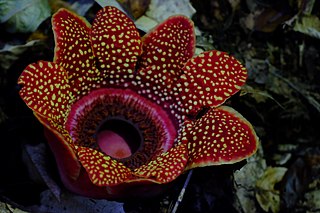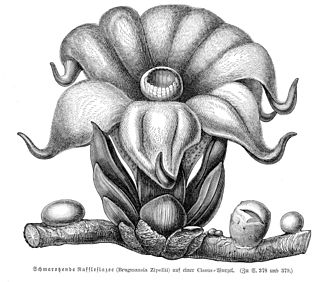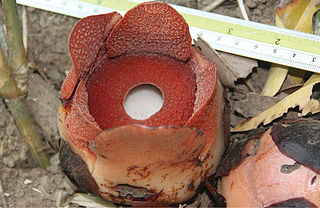
Rafflesia, or stinking corpse lily, is a genus of parasitic flowering plants in the family Rafflesiaceae. The species have enormous flowers, the buds rising from the ground or directly from the lower stems of their host plants; one species has the largest flower in the world. Plants of the World Online lists up to 41 species from this genus, all of them are found throughout Southeast Asia.

Rafflesia arnoldii, the corpse flower, or giant padma, is a species of flowering plant in the parasitic genus Rafflesia. It is noted for producing the largest individual flower on Earth. It has a strong and unpleasant odor of decaying flesh. It is native to the rainforests of Sumatra and Borneo. Although there are some plants with larger flowering organs like the titan arum and talipot palm, those are technically clusters of many flowers.

The Rafflesiaceae are a family of rare parasitic plants comprising 36 species in 3 genera found in the tropical forests of east and southeast Asia, including Rafflesia arnoldii, which has the largest flowers of all plants. The plants are endoparasites of vines in the genus Tetrastigma (Vitaceae) and lack stems, leaves, roots, and any photosynthetic tissue. They rely entirely on their host plants for both water and nutrients, and only then emerge as flowers from the roots or lower stems of the host plants.

Sapria is a genus of parasitic flowering plants in the family Rafflesiaceae. It grows within roots of Vitis and Tetrastigma. The genus is limited to the tropical forests of South and Southeast Asia.

Pieter B. Pelser is a lecturer in Plant Systematics and the curator of the herbarium at the University of Canterbury in Christchurch, New Zealand. One research interest is the evolutionary history of the tribe Senecioneae, one of the largest tribes in the largest family of flowering plants. He wrote the most recent attempt to define and delimit this tribe and its problematic founding species Senecio. He also studies insects that eat these plants (Longitarsus) which contain pyrrolizidine alkaloids and what makes them choose which plants they eat.

Rafflesia tuan-mudae is a member of the Rafflesiaceae family. It lives as a parasite within the Tetrastigma vines. The enormous flowers may reach over 1 m in diameter. The buds normally emerge where the vine is growing along the ground, unlike some of the other Rafflesia species whose buds can emerge from vines hanging in the air.
Rafflesia philippensis is a parasitic plant species of the Rafflesiaceae family that was named by Francisco Manuel Blanco in his Flora de Filipinas in 1845. The species is known only from a mountain located between the provinces of Laguna and Quezon, Luzon where it was first discovered. Its plant host is Tetrastigma pisicarpum. This species went unnoticed since its first description by Blanco but was rediscovered in 2003 by members of the Tanggol Kalikasan, a local environment conservation group in Quezon province who first saw and photographed the open flower of this species. It was brought to the attention of Manuel S. Enverga University (MSEUF), who formed a team composed of students and faculty to document the newly discovered Rafflesia species.

Rafflesia schadenbergiana is a parasitic plant species of the genus Rafflesia. Known as "bó-o" to the Bagobo tribe and "kolon busaw" to the Higaonon tribe of Bukidnon, it has the largest flower among the Rafflesia species found in the Philippines with a diameter ranging from 52 to 80 centimeters. It has also the second largest flower in the genus after R. arnoldii.
Rafflesia patma is a parasitic plant species of the genus Rafflesia. It is only known to grow on the Indonesian island of Java, although it may have occurred on Sumatra in the past. Like other species in its genus, this plant has no leaves, stems, roots or chlorophyll, instead stealing all its nutrition from Tetrastigma lanceolaurium, a rainforest liana.

Rafflesia zollingeriana is a species of flowering plant in the family Rafflesiaceae, native to Java. Of three species of Rafflesia known from Java this species has always been the most rare and restricted, it is only known from collection locales in Banyuwangi Regency, Jember Regency and Lumajang Regency, southern East Java. It was first scientifically collected in 1902 by Sijfert Hendrik Koorders on the eastern flanks of Mount Puger Watangan, a forested hill near the beach, who described it as a new species in 1918. Many decades later a flowering plant was discovered in Meru Betiri National Park, also in the Jember Regency somewhat further down the coast to the east.

Rhizanthes is a genus of four species of parasitic flowering plants in the family Rafflesiaceae. They are without leaves, stems, roots, or photosynthetic tissue, and grow within the roots of a few species of Tetrastigma vines. The genus is limited to the tropical forests of Southeast Asia. The flowers of Rhizanthes are very large, they vary from 14 to 43 cm in diameter. At least one species of Rhizanthes, Rh. lowii, is endothermic.
Rhizanthes zippelii is a species of parasitic flowering plant without leaves, stems, roots, or photosynthetic tissue. Its flowers bud out of the roots of the Tetrastigma vine. It is found in the tropical rainforests of Java. The flowers are reddish-brown, with long hanging tips, and are from 12 to 29 cm across.
Julie F. Barcelona is a Filipina botanist and taxonomist working as Research Associate at University of Canterbury. She is mostly known for her research on the Philippine members of the genus Rafflesia.

Rafflesia consueloae is a parasitic plant species of the genus Rafflesia endemic to the island of Luzon in the Philippines. It is the smallest species of the genus Rafflesia.

Tetrastigma leucostaphylum, the Indian chestnut vine, is a flowering plant in the family Vitaceae. It is native to Sri Lanka, India, Nepal and South East Asia.

Daniel Lee Nickrent is an American botanist, working in plant evolutionary biology, including the subdisciplines of genomics, phylogenetics, systematics, population genetics, and taxonomy. A major focus has been parasitic flowering plants, particularly of the sandalwood order (Santalales). His interest in photographic documentation and photographic databases has led to several photographic databases including Parasitic Plant Connection, Phytoimages, Plant Checklist for the Rocky Mountain National Park, and Plant Checklist for the Crab Orchard National Wildlife Refuge.
Danilo S. Balete, also known as Danny Balete, was a Filipino zoologist and biologist. His is known for his work on the Philippines' endemic mammal species. He pursued the question of what determines species diversity. The research by Balete and his team overturned previously held notions that diversity decreased in mountainous regions, showing that harsh environments could generate, rather than suppress, species diversity.
Rafflesia meijeri is a species of parasitic flowering plant in the genus Rafflesia. It was first described by Harry Wiriadinata and Rismita Sari in 2010. It is known from a single location, Sicikeh-Cikeh, a nature park in North Sumatra.
Rafflesia lawangensis is a species of parasitic plant in the genus Rafflesia. It is exclusively found in Bukit Lawang, a small tourist village in Mount Leuser National Park, North Sumatra, Indonesia. Previously misidentified as Rafflesia arnoldii, photographs taken in 2005 led to the eventual separation of Rafflesia lawangensis as a distinct species in 2010.












